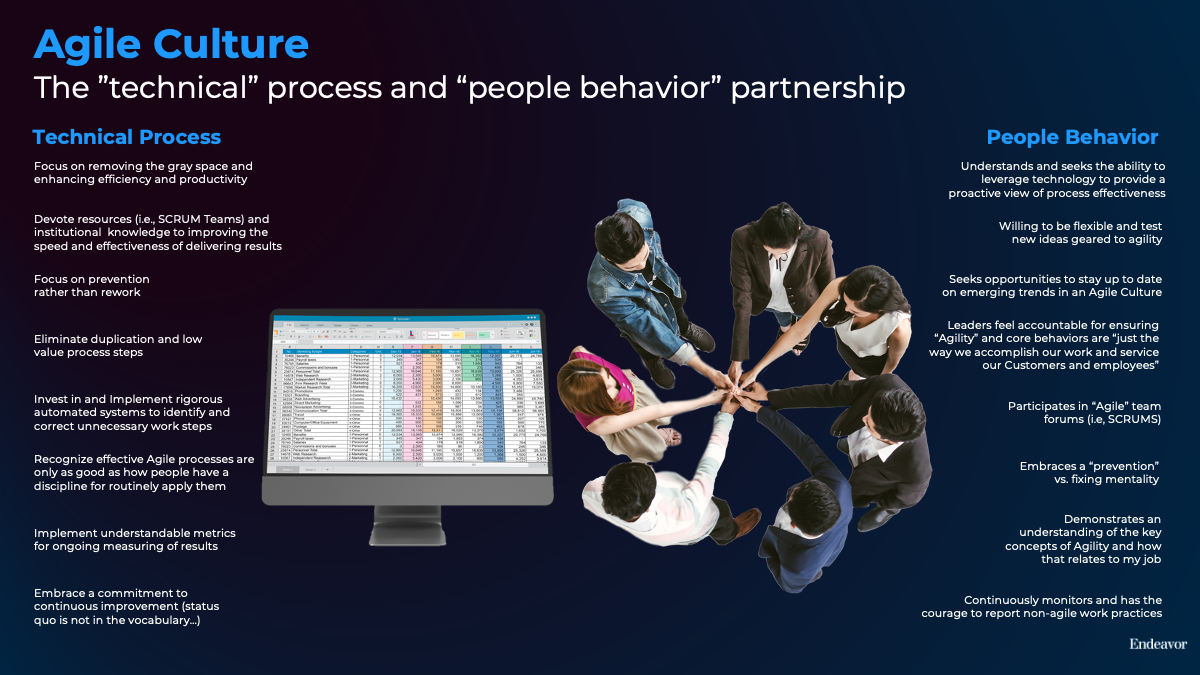
Agile
Leadership
Series
Agile Culture
The ”technical” process and “people behavior” partnership
As the “Agile Culture” revolution has evolved, not surprisingly, there has been an intersection between where the “technical process” factors meet the “behavioral” / “people-focused” factors.
For years, professionals with more technical backgrounds have been understandably concerned about putting too much emphasis on the “soft” side of the business and not enough on the “hard,” measurable process optimization side.
We believe that research supports both sides and both are critical to achieving and sustaining the intended benefits of adopting an “Agile Culture.” Recent studies have shown that a primary reason that “Agile initiatives” fail or end up on the shelf is a lack of attention to how the people expected to implement an agile approach in how work is performed, teams collaborate, problems are solved, and decisions made routinely behave and perform to make an Agile approach succeed. In essence, the best Agile cultures create a closely linked partnership across the technical and behavioral pieces of the puzzle.
We’ve included an illustration of some of the critical success factors that can come together to increase the probability of achieving the proven benefits that a truly agile culture can deliver.
Technical Process
- Focus on removing the gray space and enhancing efficiency and productivity
- Devote resources (i.e., SCRUM Teams) and institutional knowledge to improving the speed and effectiveness of delivering results
- Focus on prevention rather than rework
- Eliminate duplication and low-value process steps
- Invest in and implement rigorous automated systems to identify and correct unnecessary work steps
- Recognize effective agile processes are only as good as how people have the discipline to routinely apply them
- Embrace a commitment to continuous improvement (status quo is not in the vocabulary)
- Implement understandable metrics for ongoing measuring of results
People Behavior
- Demonstrates an understanding of the key concepts of agility and how that relates to my job
- Continuously monitors and has the courage to report non-agile work practices
- Participates in agile team forums (I.e., SCRUMS)
- Embraces a prevention vs. fixing mentality
- Understands and seeks the ability to leverage technology to provide a proactive view of process effectiveness
- Willing to be flexible and test new ideas geared to agility
- Seeks opportunities to stay up to date on emerging trends in agile culture
- Leaders feel accountable for ensuring agility and core behaviors are “just the way we accomplish our work and service our customers and employees”

Make sure you read our other posts on this series: Agile Workforce Planning, Agile HR, and Agile Talent Management.
If you would like to learn more about how Endeavor Management may be able to help, please feel free to reach out to Gerry Gibson at ggibson@endeavormgmt.com
Let’s Talk
We will help you overcome strategic challenges to realize the business value you seek.

